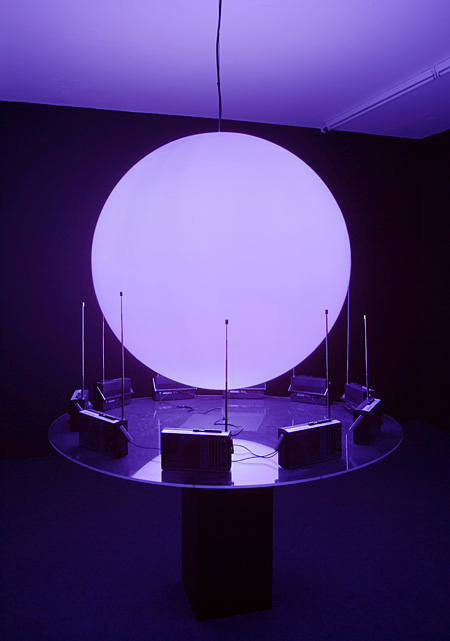 |
Fear of the black planet 2008
Sphère PVC, bois, plexiglas, moteur, transistors, émetteur FM et lecteur CD,
220 cm x 160 cm x 160 cm
Collection CNAP
PVC sphere, wood, plexiglas, motor, radios, FM transmitter
and CD player
Vue de l'exposition / exhibition Mais qu’est-il arrivé à cette musique ?, Villa Arson, Nice
Photographie Jean Brasille |
| |
La vérité a un côté absolu assez désagréable, aucune concession n’est possible et on ne peut jamais revenir dessus. En revanche, les mythes savent s’adapter, eux : ils sont en constante évolution, ils peuvent être modifiés, modelés, ils sont malléables, à l’image du temps et de l’espace.
Aurélien Tchiemessom in Sun Ra, un Noir dans le cosmos (2005)
Marcus Boon, journaliste à The Wire, à qui l’on demande un jour de décrire la plus impressionnante performance live à laquelle il ait assistée, relate son expérience, à la mi-temps des années 80 dans les quartiers populaires de New York. Il parle de centaines de ghetto blasters et d’autoradios qui, synchronisés sur la même station FM, hurlent à l’unisson à travers les rues et les avenues Rebel Without a Pause, le single dévastateur de Public Enemy. Parfois un gars dérape sur un bouton ou pousse le mauvais, se désynchronise, joue faux et se recale la mesure suivante, mais peu importe. Boon évoque les effets de delay et de reverb que génère cet étrange orchestre, la spacialisation désorganisée de l’ensemble, le son qui bouge, se meut de block en block et semble prendre vie pour porter plus loin ses propos militants. Il se trouve au milieu d’un gigantesque concert improvisé de transistors où personne n’a jamais entendu parler de John Cage et des avant-gardes de Manhattan. Personne n’a jamais jugé bon de les mettre au courant et aujourd’hui, ils s’en foutent. Ils réinventent en plus grand, en plus fort, en plus radical et plus beau cette forme éphémère.
Ailleurs, plus tard, plus loin, après que la nuit soit tombée et que la fête soit terminée, plus haut, beaucoup plus haut, des utopies, déçues d’avoir été trop éphémères, tentent un ultime baroud d’honneur. Monument à l’afro-futurisme qui se rêve grandiose ; message parasité, brouillé, humilié ; lumière noire qui peine à être phare ; orbite embouteillée qui psalmodie un trémolo paresseux ; activités satellites qui contournent le noyau du problème ; disque qui se croit invisible ; voix à peine audible ; la place de l’espace, encore et toujours, quand il ne reste plus que ça, quand plus personne n’attend plus rien de la Planète noire, de ses ombres et de ses lumières, à quoi peut bien encore servir Sun Ra ? Nous protègera-t-il encore ? Nous voulons y croire. A.M.
There is a rather unpleasantly absolute aspect to truth, compromise is impossible, and one can never go back on it. On the other hand, myths know how to adapt: they are constantly evolving, they can be modified, shaped, they are malleable, like time and space.
Aurélien Tchiemessom in Sun Ra, a Black Man in Space (2005)
Marcus Boon, reporter for The Wire, was asked one day to describe the most impressive live performance he had seen, and he related his mid-eighties experience in a working class neighbourhood in New York. He spoke of hundreds of ghetto blasters and car radios tuned to the same FM station, yelling Public Enemy’s devastating single album, Rebel Without a Pause, down streets and avenues. Once in a while a guy slipped on a button or pressed the wrong one, got desynchronised, played out of tune and got back in at the next bar, but it didn’t matter. Boon evoked the delay and reverb effects generated by this strange orchestra, the disorganised spatial effect of the whole, the sound that moved, went from block to block and seemed to come alive to carry its political message further. He was in the middle of a gigantic improvised transistor concert where no one had ever heard of John Cage or of the Manhattan avant-gardes. It had never occurred to anybody to tell them , and on that day, they didn’t care. They were reinventing this transient form of expression, making it bigger, stronger, and more beautiful.
Elsewhere, later, further, after night has fallen and the party has ended, higher, much higher, utopias attempt one last fight, disappointed in having been too fugitive. A monument to an afro-futurism that dreamt of becoming grand ; a message interfered with, blurred, humiliated; a black light unable to become a beacon ; a congested orbit chanting a lazy tremolo ; satellite activities by passing the core of the problem; a record that thinks it’s invisible ; a barely audible voice; space is the place, forever again, when nothing else is left, when nobody expects anything of the Black Planet any longer, of its shadows and of its lights, how can Sun Ra still be useful to us? Will he continue to protect us? We want to believe it. |
|
|
|